The Mixed Signal IC Market is estimated to be valued at USD 135.5 billion in 2025 and is projected to reach USD 220.7 billion by 2035, registering a compound annual growth rate (CAGR) of 5.0% over the forecast period. This growth reflects a multiplier of 1.63x, supported by a steady CAGR of 5%, driven by the increasing demand for advanced communication systems, consumer electronics, automotive sensors, and industrial applications.
In the first five-year phase (2025 to 2030), the market is expected to expand from USD 135.5 billion to USD 172.6 billion, adding USD 37.1 billion, which accounts for 43.5% of total incremental growth, as digital transformation accelerates across industries. The second phase (2030 to 2035) contributes USD 48.1 billion, representing 56.5% of incremental growth, as mixed-signal ICs play a central role in powering next-generation technologies such as IoT devices, autonomous vehicles, and 5G infrastructure.
Annual increments increase from USD 7 billion in early years to approximately USD 9.5 billion by 2035, indicating a steady expansion as more industries integrate these solutions into their systems. Manufacturers focusing on system-on-chip (SoC) solutions and energy-efficient designs will capture the largest share of this USD 85.2 billion opportunity, particularly in emerging markets and advanced technology applications.
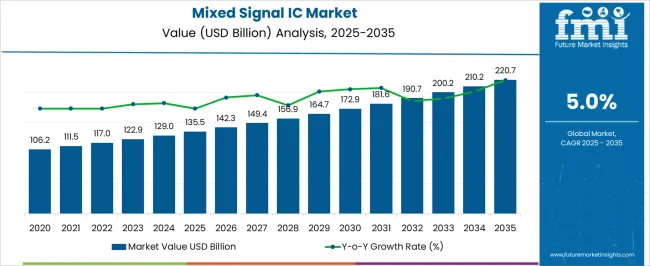
| Metric | Value |
|---|---|
| Mixed Signal IC Market Estimated Value in (2025 E) | USD 135.5 billion |
| Mixed Signal IC Market Forecast Value in (2035 F) | USD 220.7 billion |
| Forecast CAGR (2025 to 2035) | 5.0% |
The mixed signal IC market is witnessing sustained growth due to rising demand for multifunctional and space-efficient semiconductor solutions across consumer, automotive, and industrial domains. As product development cycles shorten and devices become more compact, integration of analog and digital components into a unified architecture has gained momentum.
The market is further supported by the growing proliferation of IoT devices, portable electronics, and energy-efficient systems that rely on precise signal conversion. Innovations in fabrication technology, design automation tools, and packaging have enhanced mixed signal IC performance in terms of power consumption, noise immunity, and latency.
The convergence of wireless communication protocols with edge processing has also strengthened the relevance of these ICs in modern system architectures. Future growth is expected to benefit from the expansion of 5G networks, EV adoption, and advances in wearable and medical device electronics.
The mixed signal IC market is segmented by type, end-use industry, and geographic regions. By type, the mixed signal IC market is divided into Mixed-Signal System-On-Chip, Mixed-Signal Microcontrollers, Data Converters, and Others. In terms of end-use industry, the mixed signal IC market is classified into Consumer Electronics, Healthcare, Telecommunication, Automotive, Aerospace & Defense, and Others. Regionally, the mixed signal IC industry is classified into North America, Latin America, Western Europe, Eastern Europe, Balkan & Baltic Countries, Russia & Belarus, Central Asia, East Asia, South Asia & Pacific, and the Middle East & Africa.
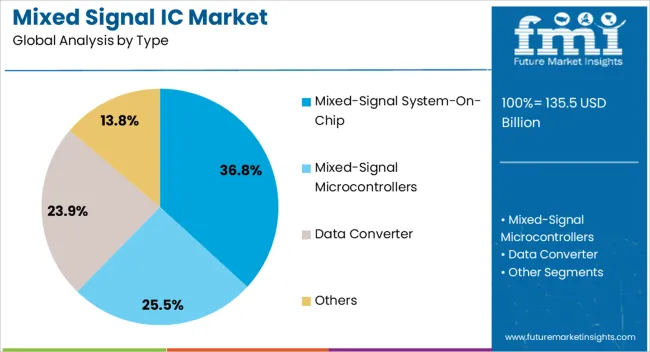
Mixed-signal system-on-chip (SoC) is projected to account for 36.8% of the total revenue in the mixed signal IC market by 2025, making it the leading product type. This segment's leadership is being driven by its ability to consolidate analog and digital functionalities within a single chip, reducing board space, power consumption, and component costs.
Mixed-signal SoCs have gained widespread use in consumer devices, smart appliances, and automotive control systems, where miniaturization and performance are critical. Their integrated architecture enables more efficient communication between components, leading to faster data processing and improved overall system reliability.
Enhanced compatibility with modern manufacturing nodes and support for embedded security and wireless features further elevate the strategic value of mixed-signal SoCs in high-volume electronics production.
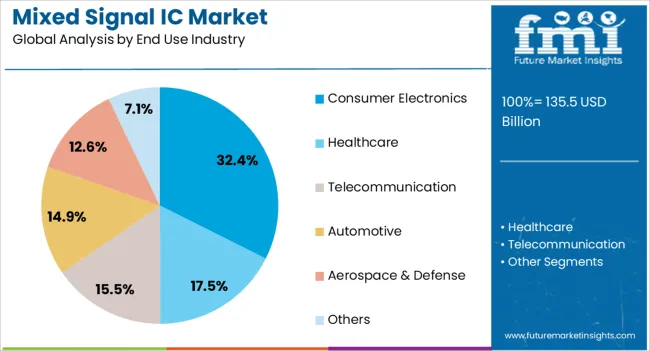
The consumer electronics segment is expected to contribute 32.4% of the total market revenue in 2025, making it the dominant end-use industry for mixed signal ICs. Growth in this segment is being fueled by increasing demand for multifunctional, connected, and compact electronic devices such as smartphones, tablets, wearable tech, and smart home systems.
Mixed signal ICs enable essential functions like signal processing, power management, and audio-video interfacing in these devices. The consumer electronics sector's constant innovation cycle, combined with high production volumes, has incentivized chipmakers to focus on scalable and application-specific mixed signal designs.
Furthermore, the integration of AI, voice control, and wireless connectivity has raised the performance requirements for ICs, further solidifying their role in enhancing user experience, device responsiveness, and battery efficiency.
The mixed signal IC market is experiencing growth due to the increasing demand for efficient signal processing in electronics. In 2024 and 2025, growth drivers include rising demand in consumer electronics, automotive, and industrial sectors. Opportunities lie in the integration of mixed signal ICs into IoT devices and smart applications. Emerging trends include the rise of 5G networks and advanced communication technologies. However, market restraints such as high production costs and the complexity of integration may hinder adoption in some regions.
The major growth driver for the mixed signal IC market is the increasing demand from consumer electronics and automotive sectors. In 2024, the rising demand for smartphones, wearables, and home appliances that require efficient signal processing drove the adoption of mixed signal ICs. The automotive industry also contributed significantly to market growth, with ICs being used for electric vehicles (EVs) and advanced driver-assistance systems (ADAS), boosting demand for integrated and compact electronic solutions.
Opportunities in the mixed signal IC market exist in the integration of these components into IoT devices and smart applications. In 2025, the growing demand for smart homes, connected devices, and industrial automation systems created significant growth opportunities for mixed signal ICs. These ICs offer efficient power management and signal processing capabilities required for IoT and smart devices. As the adoption of connected technologies continues to rise, manufacturers are increasingly focusing on delivering high-performance mixed signal ICs to cater to this growing need.
Emerging trends in the mixed signal IC market are driven by the expansion of 5G networks and advanced communication systems. In 2024, the rollout of 5G technology fueled demand for ICs capable of handling high-speed data transmission and signal processing. Mixed signal ICs, offering both analog and digital functionality, are essential for 5G devices, contributing to their increasing use in telecom infrastructure and communication equipment. The ongoing transition to 5G networks is expected to accelerate the demand for these ICs in the coming years.
The key restraints in the mixed signal IC market include high production costs and integration complexity. In 2024 and 2025, the advanced fabrication techniques required for producing mixed signal ICs increased manufacturing costs, especially for high-performance devices. Furthermore, the complexity involved in integrating these ICs into various applications, such as consumer electronics and automotive systems, posed challenges for broader adoption. As the demand for more advanced and integrated solutions grows, overcoming these technical barriers is essential to unlocking further market potential.
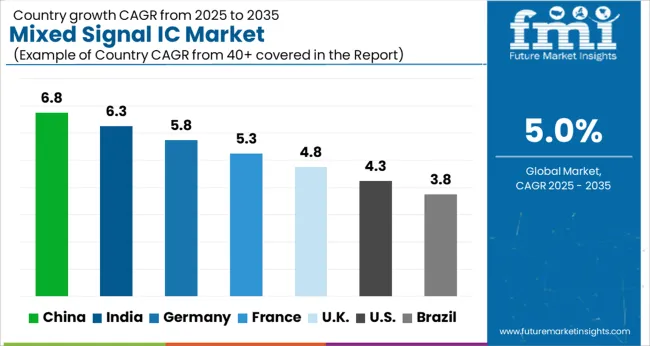
The global mixed signal IC market is projected to grow at 5% CAGR from 2025 to 2035. China leads with 6.8% CAGR, driven by the rapid expansion of the semiconductor industry, increasing demand for electronic products, and China’s focus on developing advanced electronics for consumer and industrial applications. India follows at 6.3%, supported by the rise in demand for consumer electronics, automotive applications, and industrial automation.
France records 5.3% CAGR, reflecting steady demand for mixed signal ICs in telecommunications, automotive, and industrial sectors. The United Kingdom grows at 4.8%, while the United States posts 4.3%, reflecting steady growth in mature markets with a focus on advanced mixed signal solutions for consumer electronics, telecommunications, and automotive applications. Asia-Pacific leads in market growth, while Europe and North America focus on innovation and high-performance solutions. This report includes insights on 40+ countries; the top markets are shown here for reference.
The mixed signal IC market in China is forecasted to grow at 6.8% CAGR, driven by the increasing demand for consumer electronics, automotive applications, and industrial automation. As China continues to develop its semiconductor capabilities, there is a growing demand for high-performance mixed signal ICs, which combine analog and digital signal processing for improved functionality. Government initiatives to support the semiconductor sector and the rise of AI, IoT, and smart devices further boost market growth.
The mixed signal IC market in India is projected to grow at 6.3% CAGR, supported by increasing demand for consumer electronics, telecommunications, and automotive sectors. India’s rising middle class, along with government policies aimed at boosting the electronics manufacturing industry, fosters the adoption of mixed signal ICs in various applications. Additionally, the growing automotive sector, with increasing demand for advanced driver assistance systems (ADAS), drives market growth.
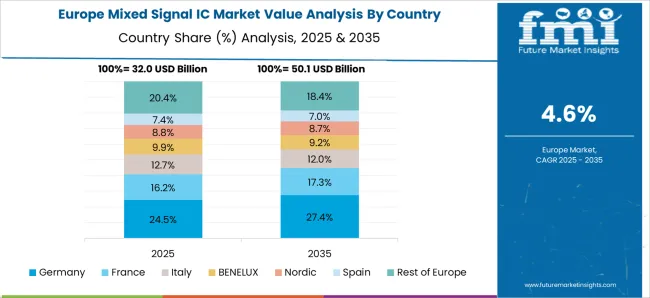
The mixed signal IC market in France is expected to grow at 5.3% CAGR, driven by the need for advanced IC solutions in telecommunications, automotive, and industrial sectors. France’s automotive industry, particularly in the areas of electric vehicles and autonomous driving, increasingly adopts mixed signal ICs for advanced functionalities. Additionally, the growing demand for 5G networks and telecommunications infrastructure accelerates the need for these integrated circuits.
The mixed signal IC market in the United Kingdom is projected to grow at 4.8% CAGR, supported by increasing demand in automotive, telecommunications, and consumer electronics sectors. The UK’s strong automotive industry, along with the growing demand for Internet of Things (IoT) and smart devices, accelerates the use of mixed signal ICs. Additionally, the push for smart cities and infrastructure improvements further drives the demand for integrated circuit solutions.
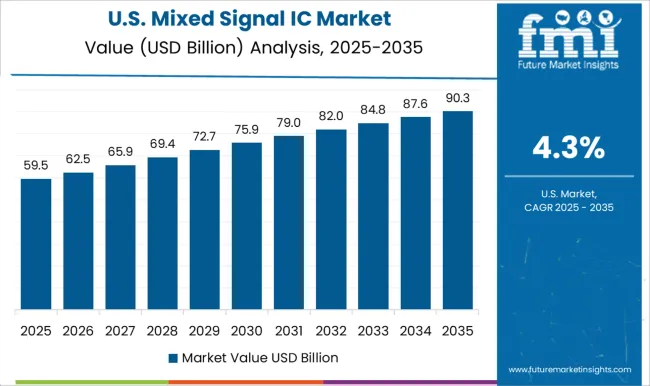
The mixed signal IC market in the United States is projected to grow at 4.3% CAGR, reflecting steady demand in a mature market with a focus on advanced technology solutions. As the USA continues to lead in the adoption of 5G networks, autonomous vehicles, and smart technologies, the need for high-performance mixed signal ICs continues to rise. The growth of AI, IoT, and connected devices further boosts the market.
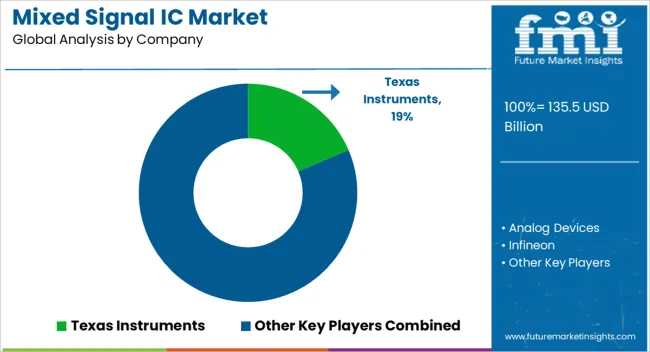
The mixed signal IC market is dominated by Texas Instruments, which secures its leadership through a comprehensive range of high-performance analog and digital mixed signal integrated circuits designed for applications in automotive, telecommunications, industrial, and consumer electronics. Texas Instruments' dominance is reinforced by its robust R&D capabilities, broad product portfolio, and strong market presence.
Key players such as Analog Devices, Infineon, Microchip Technology, and STMicroelectronics hold significant market shares by providing innovative mixed signal IC solutions that integrate analog-to-digital and digital-to-analog conversion, power management, and signal processing features. These companies focus on delivering high-performance, low-power solutions for diverse applications, meeting the growing demand for efficient, compact ICs in modern electronics.
Emerging players like NXP Semiconductors and others are strengthening their market position by offering cost-effective mixed signal ICs designed for specific applications such as automotive safety, IoT devices, and industrial automation. Their strategies include enhancing signal processing capabilities, improving energy efficiency, and addressing the increasing demand for multi-functional ICs.
Market growth is driven by the rising demand for integrated, energy-efficient solutions, increasing automation in various industries, and the rapid development of connected devices. Continuous innovation in semiconductor fabrication processes and the growing trend of miniaturization are expected to shape competitive dynamics and fuel expansion in the global mixed signal IC market.
| Item | Value |
|---|---|
| Quantitative Units | USD 135.5 Billion |
| Type | Mixed-Signal System-On-Chip, Mixed-Signal Microcontrollers, Data Converter, and Others |
| End Use Industry | Consumer Electronics, Healthcare, Telecommunication, Automotive, Aerospace & Defense, and Others |
| Regions Covered | North America, Europe, Asia-Pacific, Latin America, Middle East & Africa |
| Country Covered | United States, Canada, Germany, France, United Kingdom, China, Japan, India, Brazil, South Africa |
| Key Companies Profiled | Texas Instruments, Analog Devices, Infineon, Microchip Technology, NXP Semiconductor, and STMicroelectronics |
| Additional Attributes | Dollar sales by IC type and application, demand dynamics across consumer electronics, automotive, and telecommunications sectors, regional trends in mixed signal IC adoption, innovation in low-power and high-speed processing technologies, impact of regulatory standards on electromagnetic compatibility, and emerging use cases in IoT devices and wearable technologies. |
The global mixed signal IC market is estimated to be valued at USD 135.5 billion in 2025.
The market size for the mixed signal IC market is projected to reach USD 220.7 billion by 2035.
The mixed signal IC market is expected to grow at a 5.0% CAGR between 2025 and 2035.
The key product types in mixed signal IC market are mixed-signal system-on-chip, mixed-signal microcontrollers, data converter and others.
In terms of end use industry, consumer electronics segment to command 32.4% share in the mixed signal IC market in 2025.






Our Research Products

The "Full Research Suite" delivers actionable market intel, deep dives on markets or technologies, so clients act faster, cut risk, and unlock growth.

The Leaderboard benchmarks and ranks top vendors, classifying them as Established Leaders, Leading Challengers, or Disruptors & Challengers.

Locates where complements amplify value and substitutes erode it, forecasting net impact by horizon

We deliver granular, decision-grade intel: market sizing, 5-year forecasts, pricing, adoption, usage, revenue, and operational KPIs—plus competitor tracking, regulation, and value chains—across 60 countries broadly.

Spot the shifts before they hit your P&L. We track inflection points, adoption curves, pricing moves, and ecosystem plays to show where demand is heading, why it is changing, and what to do next across high-growth markets and disruptive tech

Real-time reads of user behavior. We track shifting priorities, perceptions of today’s and next-gen services, and provider experience, then pace how fast tech moves from trial to adoption, blending buyer, consumer, and channel inputs with social signals (#WhySwitch, #UX).

Partner with our analyst team to build a custom report designed around your business priorities. From analysing market trends to assessing competitors or crafting bespoke datasets, we tailor insights to your needs.
Supplier Intelligence
Discovery & Profiling
Capacity & Footprint
Performance & Risk
Compliance & Governance
Commercial Readiness
Who Supplies Whom
Scorecards & Shortlists
Playbooks & Docs
Category Intelligence
Definition & Scope
Demand & Use Cases
Cost Drivers
Market Structure
Supply Chain Map
Trade & Policy
Operating Norms
Deliverables
Buyer Intelligence
Account Basics
Spend & Scope
Procurement Model
Vendor Requirements
Terms & Policies
Entry Strategy
Pain Points & Triggers
Outputs
Pricing Analysis
Benchmarks
Trends
Should-Cost
Indexation
Landed Cost
Commercial Terms
Deliverables
Brand Analysis
Positioning & Value Prop
Share & Presence
Customer Evidence
Go-to-Market
Digital & Reputation
Compliance & Trust
KPIs & Gaps
Outputs
Full Research Suite comprises of:
Market outlook & trends analysis
Interviews & case studies
Strategic recommendations
Vendor profiles & capabilities analysis
5-year forecasts
8 regions and 60+ country-level data splits
Market segment data splits
12 months of continuous data updates
DELIVERED AS:
PDF EXCEL ONLINE
Mixed Acetic and Tartaric Acid Esters of Mono and Diglycerides of Fatty Acids Market
Signaling Device Market – Industrial Safety & Automation
Traffic Signal Controller Market
Pre-mixed/RTD Alcoholic Drink Market Analysis - Size, Share, and Forecast Outlook 2025 to 2035
Audible and Visual Signaling Devices Market Analysis by Product Type, End-Use Industry, and Region through 2035
Mixed Reality Navigation Platforms Market Forecast and Outlook 2025 to 2035
Ice Cream Coating Market Size and Share Forecast Outlook 2025 to 2035
Signal Analyzer Market Size and Share Forecast Outlook 2025 to 2035
Ice-cream Premix and Stabilizers Market Size and Share Forecast Outlook 2025 to 2035
ICE Start And Stop System Market Size and Share Forecast Outlook 2025 to 2035
Signal Conditioning Modules Market Size and Share Forecast Outlook 2025 to 2035
Mixed Reality Surgery Market Analysis - Size and Share Forecast Outlook 2025 to 2035
ICD-10 Market Size and Share Forecast Outlook 2025 to 2035
Ice Cream Equipment Market Size and Share Forecast Outlook 2025 to 2035
Signals Intelligence (SIGINT) Market Size and Share Forecast Outlook 2025 to 2035
Ice Boxes Market Size and Share Forecast Outlook 2025 to 2035
Mixed Xylene Market Trends - Demand, Innovations & Forecast 2025 to 2035
Icing Shortening Market Size, Growth, and Forecast for 2025–2035
Analysis and Growth Projections for Ice Cream and Frozen Dessert Market from 2025 to 2035
Icing Sugar Market Analysis - Size, Share, and Forecast 2025 to 2035

Thank you!
You will receive an email from our Business Development Manager. Please be sure to check your SPAM/JUNK folder too.
Chat With
MaRIA